Britomart Figures Impressive
More evidence that Auckland’s CBD rail link is critical, in terms of capacity at the city terminus.
Auckland Transport is estimating that about 25,000 rail passengers go through Britomart Station every weekday.
That is more than the daily numbers at Auckland’s domestic airport.
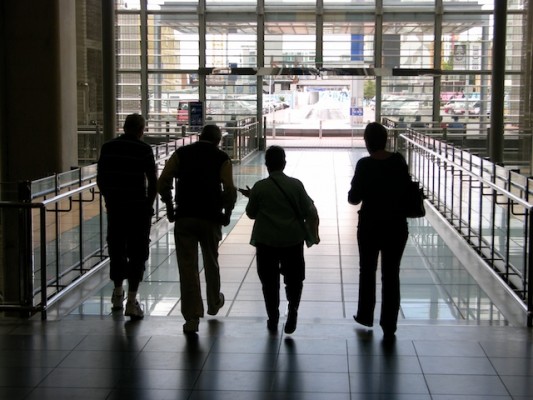 Auckland Transport’s last passenger survey at Britomart in May counted 21,000 but with recent increases in rail patronage revealed this week, that is now estimated to be 25,000.
Auckland Transport’s last passenger survey at Britomart in May counted 21,000 but with recent increases in rail patronage revealed this week, that is now estimated to be 25,000.
This compares to 14,000 domestic travellers a day through Auckland Airport. Earlier this week the number of rail passengers reached one million for the month of March.
This compares to annual patronage of 2.5 million when Britomart opened in 2003.
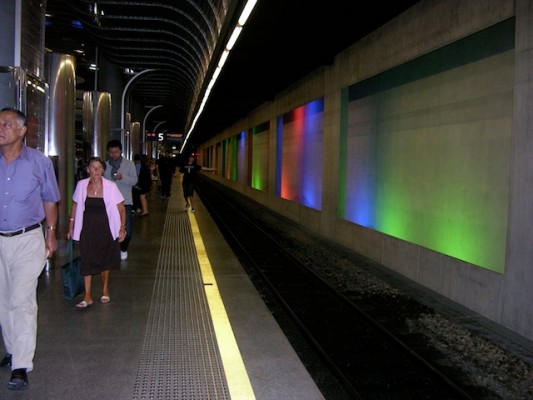 The Auckland Transport figures this week showed total public transport patronage for the past year to February reached 64 million, an increase of 8.3%.
The Auckland Transport figures this week showed total public transport patronage for the past year to February reached 64 million, an increase of 8.3%.
Now imagine what the numbers would be if the CBD rail link can let people travel to destinations around the wider inner-city, as you do in places like Sydney.
If the CBD Rail Link is built it is expected to double patronage beyond what would be normally expected.
The business case for the link mentioned that the Britomart terminus is the most serious constraint, limiting the number of train paths into and out of the CBD.
And the figures for passengers to the CBD are probably already underestimated judging by the new love affair with rail.
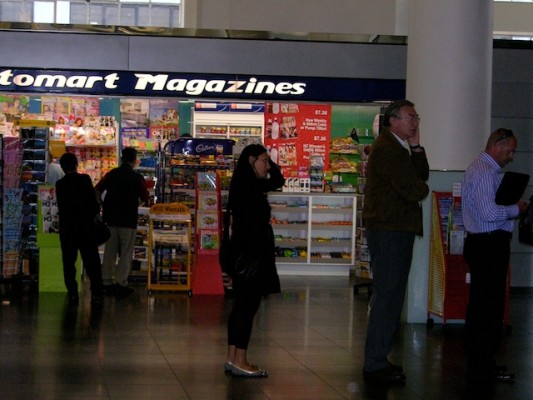 ARTA‘s post-DART and electrification peak period electric train timetable consists of 20 trains per hour in and out of Britomart during peak periods, comprised of 6 an hour on each of the Southern, Western and Eastern routes, together with 2 an hour from Onehunga.
ARTA‘s post-DART and electrification peak period electric train timetable consists of 20 trains per hour in and out of Britomart during peak periods, comprised of 6 an hour on each of the Southern, Western and Eastern routes, together with 2 an hour from Onehunga.
Thus by 2013, almost all of the useable train paths into and out of Britomart will be in use, providing virtually no room to add additional services in future.
Post electrification, passenger services will be operated largely by electric multiple unit (EMU) trains (6 cars long on all routes except for 3 cars on the Onehunga line), with a planned seated plus standing capacity of 385 for a 3 car EMU and 770 for a 6 car.
Therefore ARTA’s originally proposed 20 trains per hour service would provide an hourly carrying capacity of around 16,100- 16,200 passengers into Britomart, although the actual number of CBD passengers able to be transported by rail will in practice be determined by the number of passengers travelling to intermediate destinations such as Newmarket.
The addition of the CBD Rail Link would offer better exploitation of these improvements through penetration of the central and southern parts of the CBD, extending the service that can be provided for rail passengers. Through-routing at Britomart not only would allow for capacity utilisation, but also would afford better network optimisation from flexibility in services patterns and scheduling.
The Business Case added:
The current configuration of Britomart appears to provide adequate capacity into the CBD for rail passengers in the future; however, Britomart’s position on the northern periphery of the CBD effectively limits the catchment for CBD rail journeys to those passengers travelling to destinations within 400-500m distance of Britomart.
The rail development plan provides for the current upgrading and capacity improvements to the existing Auckland rail network (these are in progress), enabling the delivery of more passengers.
The addition of the CBD Rail Link would offer better exploitation of these improvements through penetration of the central and southern parts of the CBD, extending the service that can be provided for rail passengers. Through-routing at Britomart not only would allow for capacity utilisation, but also would afford better network optimisation from flexibility in services patterns and scheduling.
Transport modelling indicates the CBD Rail Link will dramatically alter the flow of passengers moving around the Auckland CBD, with wider transport network and economic development impacts.
This table below, taken from the CBD link Business Case, summarises the passenger flows for the CBD Rail Link configured with three stations, consistent with the base option electric service pattern discussed above.
The first column looks at the flows of people on the rail network around the stations (on trains travelling in both directions), while the other three columns summarise station usage.
The busiest part of the network in the 2041 2-hour morning peak would be the Eastern approach to Britomart, with around 17,700 passengers.
Flows on the Rail Link itself are forecast to be around 15,700 passengers on either side of Aotea station and 16,200 passengers where it leaves the Western Line.
The implications of this include:
- The new station at Aotea is forecast to become the busiest station on the network, with almost 12,000 passengers every peak compared to 9,000 at Britomart by 2041
- The three new stations in total are forecast to have over 20,000 passengers every peak in 2041
- Annual rail patronage is forecast to reach 50 million by 2041, more than twice what it would be if the Link isn’t built
- The rail link will remove around 15 million car-kilometres from the network in the year 2041.
- The number of morning peak passengers using “K” Road station would be around 5,500 and the equivalent figure for Newton is 3,300.
- The Newton station also serves as a significant transfer point for passengers changing trains between services using the CBD Rail Link and services operating to Newmarket via Grafton. However, these figures take no account of the expected regeneration impact of the stations the model has no feedback mechanism from the network to land use. In practice, the presence of the stations would lead to development in the vicinity and this would considerably increase the ridership over these forecasts.
And of course we will all benefit from the travelling times:
And how can the Government ignore the population growth in Auckland - and the numbers attracted to live around the new CBD stations as those areas get rejuvenated.
And another interesting aside in today’s Auckland Transport estimates: 13,000 use the downtown ferry terminal close to Britomart each day.



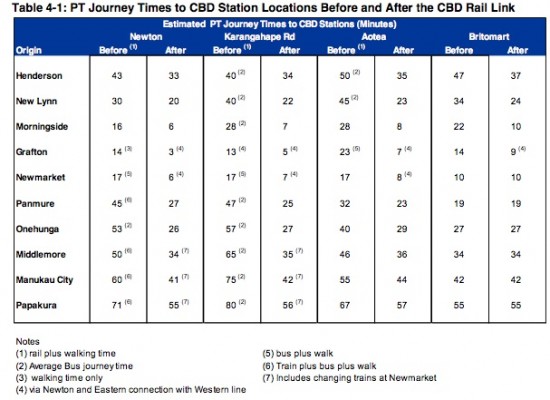

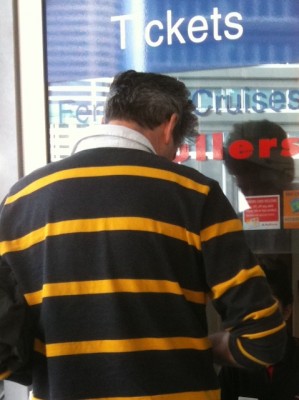










13 Comments
Great to read. Good article. I had some UK mates over and when we went through Britomart they were impressed with how clean & funky it is.
The other thing I found interesting about that announcement is they have confirmed that March was the first month ever we have had 1mil passengers on rail which is pretty impressive considering that a few short years ago we only had 2.5m trips across the whole year.
And SJ wanted to build a motorway for…what was it? 24,000 people per day?
Hi anthony……yes that was what I wanted to double-check. Hasn’t the PM and Joyce recently crowed about Puhoi-Wellsford carrying more pax per day than the Auckland rail network.
Have the tables now been turned? Is it true that one Auckland station - Britomart - now carries more pax per day than the whole Puhoi-Wellsford highway?
Anyway - to copy from an old e-mail by Westie Commuter on this site -
‘NZTA says a telemetry site on SH1 north near Wellsford carries under 9000 cars per day. More data than you could ever want is here, on Joyce’s ministry’s website, naturally: http://www.nzta.govt.nz/resources/state-highway-traffic-volumes/docs/SHTV-2005-2009.pdf
And oh boy, this one (http://www.nzta.govt.nz/resources/state-highway-traffic-growth/docs/shtg-201009.pdf) says monthly traffic on Auckland bridge is DOWN 4% from last year. It repeats that fewer than 9000 cars/day travel SH1 at Wellsford.
Can anyone figure out if the Wellsford telemetry site is the same Puhoi/Wellsford motorway he’s talking about?’
tuktuk - From memory Joyce originally claimed that on average 24000 people used the P2W route daily (including holiday times) which is obviously less than the Britomart figure. The other day John Key quoted 27k using P2W so I don’t know where that figure has come from. I also believe that the telemetry site they use is from south of Warkworth where most of the traffic then leaves the road.
Tuktuk - true. The telemetry site a few kilometers north of Wellsford has fair lower numbers of daily traffic.
Joyce and Key are lying about the numbers of cars on the road. It shows you how desperate they are to please the trucking and construction lobby.
Table 3-1 is headed both “Maximum Capacity for EMU’s” and “Trains per Hour”. But there’s still a lot of freight carried by rail, especially south of Westfield. EMU capacity will therefore be less than trains per hour. Would anyone have a feeling for how much less?
Donald Yes it is a issue so most freight trains run outside the commuter am and pm peak periods. In the medium term a third line for freight between Westfield and Wiri is planned to keep freighters and future inter regional trains out of the way of all station stopping commuter trains. Luckily the corridor is plenty wide enough there to accomodate a third line at reasonable cost. Once the Manukau spur is opened that section will be the pinch point for capacity especially in port freight shuttles from Wiri increase
Any plans for a third line to the port on the Eastern line, or at least protecting the space for the future [if not also for a forth]?
Patrick - My understanding is only the planning is only for between Wiri and Westfield as outside of that frequencies of passenger trains won’t be as high.
27,000 = 9000 * 3.
Maybe Steven Joyce said. “9000 cars with 3 people each that’s like 27,000 people.”
I expect this figure to rise to 36,000 people soon. Of course a problem arises when you say 45,000 use the route as most cars only have 5 seats. Wait a minute what if all the cars that used it were people movers. They have like 8 seats. That’s 72,000 people using that route. Isn’t maths fun?
A Third track on the Eastern line has had some very initial investigation put into it, but not nearly has seriously as the third track Wiri to Westfield which will be at least partially built in the next 5 years or so.
The 3rd eastern line is on the 20 - 30 year plan.
Haha, @James B the other side of that would be to compare 72000 people mover seats per day with network crush-loaded capacity on every AKL train service, I have a feeling that comparison would be fairly dramatic!